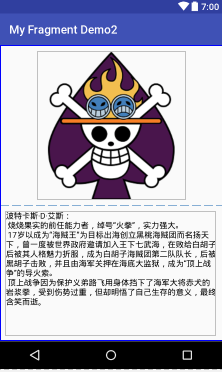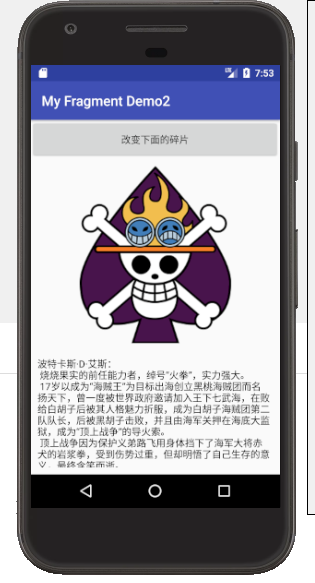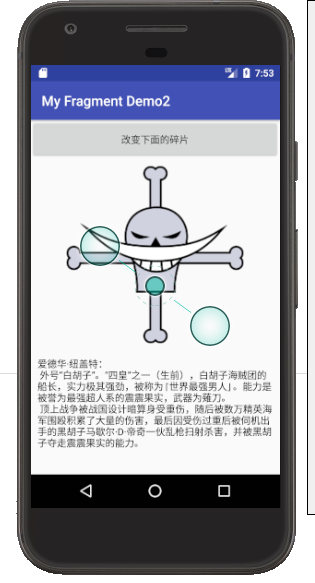实现思路
1.写一个父类布局,里面写一个按键和一个帧布局(用于给Fragment布局后续替代)
2.写3个子布局,并且在写3个class继承Fragment布局
3.在MainActivity的class中写替换碎片布局的方法
(包含:FragmentManger(碎片管理器)、getSupportFragmentManager(得到支持碎片管理器)、FragmenTransaction(碎片交换器)、beginTransaction(开始碎片交换)、replace(替换)、commit(交付))
写一个父类布局,里面写一个按键和一个帧布局
<?xml version="1.0" encoding="utf-8"?> <LinearLayout xmlns:android="http://schemas.android.com/apk/res/android" android:orientation="vertical" android:layout_width="match_parent" android:layout_height="match_parent" > <Button android:id="@+id/Button1" android:layout_width="match_parent" android:layout_height="0dp" android:layout_weight="1" android:text="改变下面的碎片"/> <FrameLayout android:id="@+id/FrameLayout1" android:layout_width="match_parent" android:layout_height="0dp" android:layout_weight="8"> </FrameLayout> </LinearLayout>
写3个子布局,并且在写3个class继承Fragment布局
<?xml version="1.0" encoding="utf-8"?> <LinearLayout xmlns:android="http://schemas.android.com/apk/res/android" android:orientation="vertical" android:layout_width="match_parent" android:layout_height="match_parent" android:padding="10dp"> <ImageView android:id="@+id/fragment_1_ImageView" android:layout_width="wrap_content" android:layout_height="wrap_content" android:layout_gravity="center" android:src="@drawable/ace"/> <TextView android:id="@+id/fragment_1_TextView" android:layout_width="match_parent" android:layout_height="match_parent" android:text="@string/ace" android:textColor="@color/colorBlack" android:layout_marginTop="20dp"/> </LinearLayout>

相同布局在写2个
写一个class继承fragment实现碎片布局实例化
package com.example.lenovo.myfragmentdemo2.fragment; // 注意Fragment的依赖库建议统一使用support-v4库中的 import android.support.v4.app.Fragment; import android.os.Bundle; import android.support.annotation.Nullable; import android.view.LayoutInflater; import android.view.View; import android.view.ViewGroup; import com.example.lenovo.myfragmentdemo2.R; /** * Created by lenovo on 2018/5/7. */ public class Fragment1 extends Fragment { @Nullable @Override public View onCreateView(LayoutInflater inflater, @Nullable ViewGroup container, Bundle savedInstanceState) { View view = inflater.inflate(R.layout.fragment_1,container,false); return view; } }
在MainActivity的class中写替换碎片布局的方法
package com.example.lenovo.myfragmentdemo2; // 注意Fragment的依赖库 import android.support.v4.app.Fragment; import android.support.v4.app.FragmentManager; import android.support.v4.app.FragmentTransaction; import android.support.v7.app.AppCompatActivity; import android.os.Bundle; import android.view.View; import android.widget.Button; import com.example.lenovo.myfragmentdemo2.fragment.Fragment1; import com.example.lenovo.myfragmentdemo2.fragment.Fragment2; import com.example.lenovo.myfragmentdemo2.fragment.Fragment3; public class MainActivity extends AppCompatActivity { private Button button; private int i = 1; @Override protected void onCreate(Bundle savedInstanceState) { super.onCreate(savedInstanceState); setContentView(R.layout.activity_main); button = (Button)findViewById(R.id.Button1); button.setOnClickListener(new View.OnClickListener() { @Override public void onClick(View v) { switch (i){ case 1: replaceFragment(new Fragment1()); i++; break; case 2: replaceFragment(new Fragment2()); i++; break; case 3: replaceFragment(new Fragment3()); i++; break; default: replaceFragment(new Fragment1()); i=1; break; } } }); } public void replaceFragment(Fragment fragment){ FragmentManager fragmentManager = getSupportFragmentManager(); FragmentTransaction transaction = fragmentManager.beginTransaction();//注意!每次要执行commit()方法的时候都需要重新获取一次FragmentTransaction,否则用已经commit过的FragmentTransaction再次commit会报错! transaction.replace(R.id.FrameLayout1,fragment); transaction.commit(); } }
运行效果:
 点击后:
点击后:
本文来自博客园,作者:观心静 ,转载请注明原文链接:https://www.cnblogs.com/guanxinjing/p/9708626.html







【推荐】国内首个AI IDE,深度理解中文开发场景,立即下载体验Trae
【推荐】编程新体验,更懂你的AI,立即体验豆包MarsCode编程助手
【推荐】抖音旗下AI助手豆包,你的智能百科全书,全免费不限次数
【推荐】轻量又高性能的 SSH 工具 IShell:AI 加持,快人一步
· 开发者必知的日志记录最佳实践
· SQL Server 2025 AI相关能力初探
· Linux系列:如何用 C#调用 C方法造成内存泄露
· AI与.NET技术实操系列(二):开始使用ML.NET
· 记一次.NET内存居高不下排查解决与启示
· 阿里最新开源QwQ-32B,效果媲美deepseek-r1满血版,部署成本又又又降低了!
· 开源Multi-agent AI智能体框架aevatar.ai,欢迎大家贡献代码
· Manus重磅发布:全球首款通用AI代理技术深度解析与实战指南
· 被坑几百块钱后,我竟然真的恢复了删除的微信聊天记录!
· AI技术革命,工作效率10个最佳AI工具